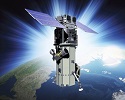WorldView-3 remote sensing spacecraft arrives at Vandenberg AFB for mid-August launch
 Ball Aerospace & Technologies Corp. has delivered the next-generation commercial remote sensing satellite built for DigitalGlobe, to the launch facility at Vandenberg Air Force Base in California. The WorldView-3 satellite is slated to fly aboard a United Launch Alliance Atlas 5 rocket in mid-August for DigitalGlobe, a leading provider of commercial high-resolution earth observation and advanced geospatial solutions.
Ball Aerospace & Technologies Corp. has delivered the next-generation commercial remote sensing satellite built for DigitalGlobe, to the launch facility at Vandenberg Air Force Base in California. The WorldView-3 satellite is slated to fly aboard a United Launch Alliance Atlas 5 rocket in mid-August for DigitalGlobe, a leading provider of commercial high-resolution earth observation and advanced geospatial solutions.
The WorldView-3 spacecraft passed a full suite of environmental, functional and performance tests in preparation for integration with the launch vehicle, along with thorough pre-ship reviews by Ball Aerospace and DigitalGlobe.
WorldView-3 is the first multi-payload, super-spectral, high-resolution commercial satellite for earth observations and advanced geospatial data. Operating at an expected altitude of 617 km, WorldView-3 will collect imagery with 31 cm resolution. This level of resolution performance would be fundamentally impossible without the 1.1 m aperture telescope and the primary visible/SWIR sensor built by Exelis, which allows for a breadth of applications unmatched by smaller, lower-performance satellites.
DigitalGlobe recently received permission from the U.S. Department of Commerce to sell its higher resolution satellite imagery, and once WorldView-3 is operational, the company will be able to deliver imagery with significantly greater clarity and spectral depth than anything else on the commercial market.
WorldView-3 also carries a Ball Aerospace-built atmospheric instrument called CAVIS, which stands for Clouds, Aerosol, water Vapor, Ice, and Snow. CAVIS will monitor the atmosphere and provide correction data when WorldView-3 images earth objects through haze, aerosols or other atmospheric obscurants.
“Ball has incorporated significant data-gathering advances into this latest addition to the DigitalGlobe constellation,” said Ball Aerospace President Rob Strain. “Our new CAVIS sensing instrument will provide atmospheric correction data that will increase the volume of usable imagery captured by the primary imaging sensor.”
The range of customer applications enabled by the DigitalGlobe constellation is greatly expanded by WorldView-3’s ability to sense both the visible spectrum as well as deeper into the infrared spectrum. Its data-rich imagery will enable customers to search for new sources of minerals and fuels, manage forests and farms, and accelerate DigitalGlobe’s creation of Geospatial Big Data — a living inventory of the surface of the earth.
“As with our previous WorldView satellites, Ball completed the development, integration and testing of the next-generation WorldView-3 satellite as promised,” said Dr. Walter Scott, executive vice president, chief technical officer and founder of DigitalGlobe. “We look forward to the satellite’s successful launch in August and to providing our customers with the most information-rich geospatial products available on the commercial market.”
WorldView-3 builds upon WorldView-2 and WorldView-1 technology by carrying forward the satellites’ advanced Control Moment Gyroscopes (CMGs). The CMGs re-orient a satellite over a desired collection area in 4-5 seconds, compared to 30-45 seconds needed for traditional reaction wheels. This enables the WorldView satellites to collect large areas far faster than competing satellites.
WorldView-3 is built on the high-performance Ball Configurable Platform (BCP) 5000 spacecraft, designed to provide a very stable, upgraded platform for the next-generation optical and synthetic aperture radar remote sensing payloads. The BCP 5000 platform provided for WV-3 under a fixed-price contract to DigitalGlobe implements increased power, resolution, agility, target selection, flexibility, transmission capability and data storage.
Ball Aerospace & Technologies Corp. supports critical missions for national agencies, such as the Department of Defense, NASA, NOAA and other U.S. Government and commercial entities. The company develops and manufactures spacecraft, advanced instruments and sensors, components, data exploitation systems and RF solutions for strategic, tactical and scientific applications.







